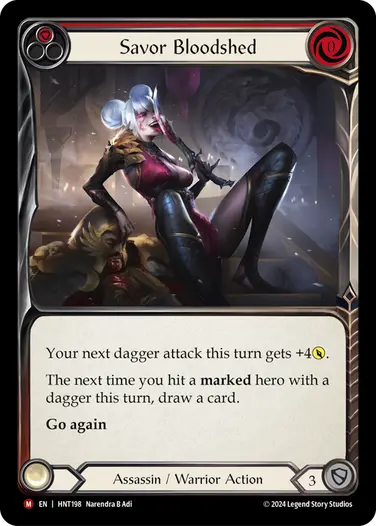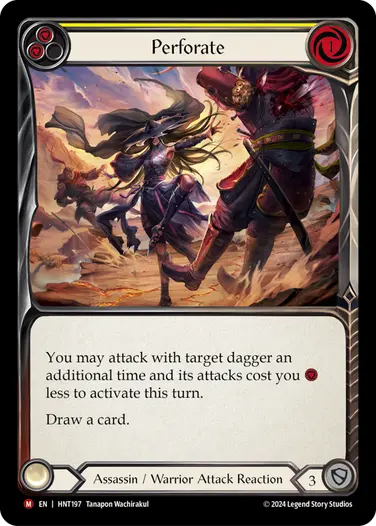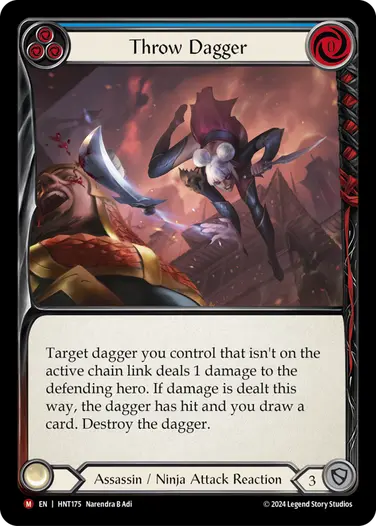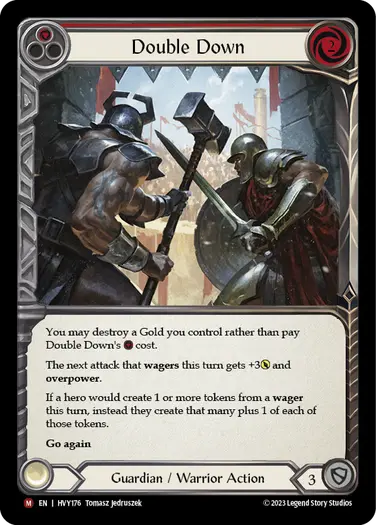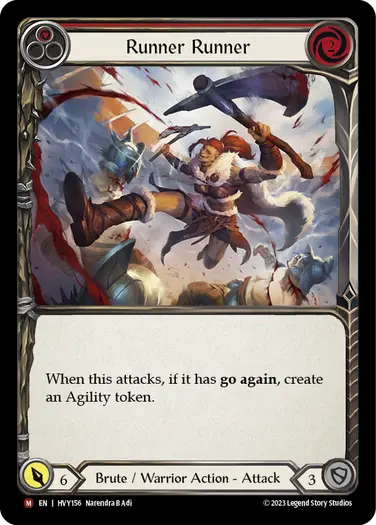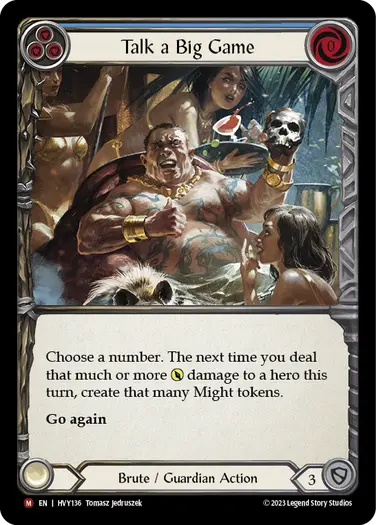Legend Story Studios developer Karol lifts the curtain of the Dev Room so we can take a peek behind the scenes. Learn about the work that went into designing, testing, and evolving the iconic cards you know and love today. Sometimes all a card needs to be great is a Dev Touch!
Heavy Hitters was the second set in Flesh and Blood to use hybrid cards. This had significant implications for limited play, while also creating unique opportunities in constructed. In particular, hybrid Majestics posed notable design and development challenges. Typically, a strong design reflects a class through both its numbers and text: a Brute card reads and feels like a Brute card, regardless of the class tag at the bottom and the same holds true for every class.
With hybrid Majestics, however, we had an opportunity to merge the themes and flavors of two classes, and that’s exactly how their design philosophy began.
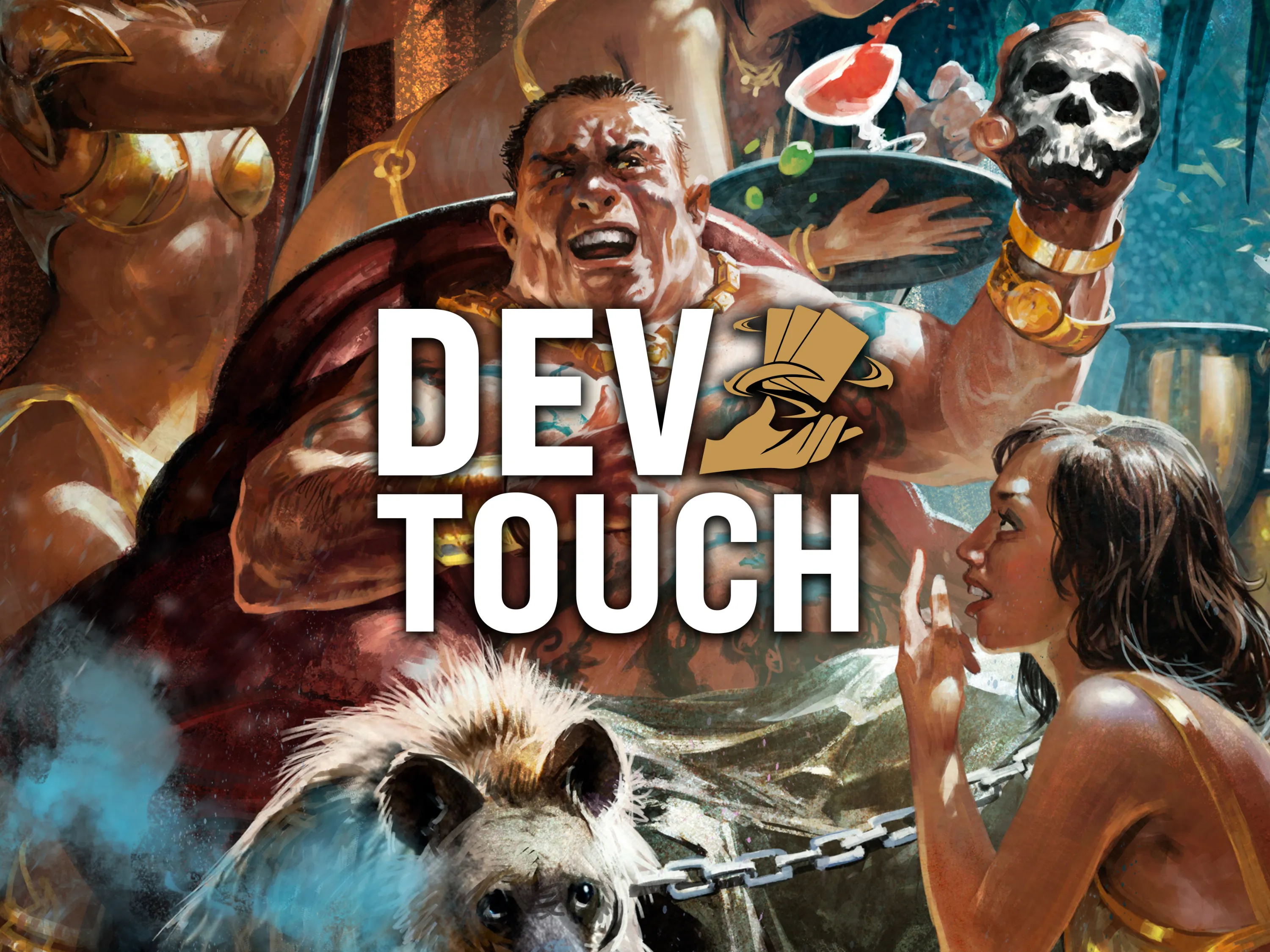
The initial combinations were exciting, with possibilities that felt endless.
- How does a Brute attack reaction sound?
- A beefy setup aura in Warrior?
- A Guardian with access to intimidate?
But in practice, these thematic overlaps were difficult to get right. The class that craved a mechanic it normally lacked often made far better use of it than the class that originally owned it. For example, the first Brute/Guardian hybrid design combined the big, beefy 3-cost Guardian auras with Brute’s intimidate mechanic. It looked something like this:
Hybrid Majestic
Brute / Guardian Action - Aura
(BLU) 3{r} 3{d}
At the start of your turn, destroy this, then the next Brute or Guardian attack action card you play this turn gets +3{p} and intimidate.
This card blended the flavors of both classes, creating something new and unique, but was also tricky for the dev team to balance. It opened the door to heroes accessing mechanics normally locked away from them, a big can of worms we had to validate across every possible hero combination. Slowly but surely, we flagged problematic designs one by one.
One major strength of our process is the hands-on involvement of our lead developers. Chris Gehring and Bryan Gottlieb are deeply engaged in development while also bringing strong design experience. This means we can communicate problems in real time, showcase them in gameplay, and get immediate design tweaks. Their input can also fast-track a problematic card to be scrapped and redesigned, and with hybrid Majestics, this happened often.
- Warriors with reaction-speed disruption?
- Guardians with attack reactions?
- Brutes with beefy setup auras?
Again and again, the same problems arose. Either the combination created something neither class really wanted, or it gave one class something from the other that proved dangerously imbalanced. Many designs fell into the dreaded "high risk, low reward" category—the least desirable outcome in card design.
As Heavy Hitters was refined, clearer themes emerged, giving the team a narrower design pathway for hybrids. We stopped trying to force both classes into a single card and instead leaned into their shared overarching themes. This philosophy can be seen later in hybrid Majestics from The Hunted, like Savor Bloodshed, Perforate, and Throw Dagger. This shift streamlined design and allowed us to create cards with a clearer identity that worked specifically in heroes who supported those themes.
Double Down was the first hybrid card locked in. A clear synergy piece with wager, it offered pump and evasion at 2-cost, slotting neatly into the Warrior/Guardian hybrid that cared about wagering. The alternate Gold cost was yet another thematic tie-in between Warrior and Guardian.
While this new approach helped create thematically strong cards that avoided earlier pitfalls, challenges remained. Many issues could be solved through development tweaks rather than full redesigns. For example, Runner Runner bounced between being a 1-cost 5-power and a 2-cost 6-power. For Heavy Hitters, the 1-cost 5-power version fit, since Kayo could convert it into a Brute staple 6-power. But in the broader Brute pool, a 5-power attack felt out of place. On the Warrior side, just having an attack card felt odd, yet a 1-cost 5-power seemed more fitting there. Ultimately, after weighing theme, playability, and balance, we landed on 2-cost 6-power.
The final card in the hybrid Majestic cycle was Talk a Big Game. The Brute / Guardian tie-ins in Heavy Hitters were predominantly Might tokens and the clash mechanic, and that’s where the first versions began.
The earliest draft was a non-attack action that clashed. The idea was that the smack-talk flavor tied to a “clash of words”, though even that interpretation was a stretch.
Talk a Big Game
Brute / Guardian Action
(RED) 0{r} 3{d}
Clash with an opposing hero. If you win, they discard 2 cards. If they win, they draw a card.
One day, Chris and Bryan walked into the Dev Room to check on progress. Talk a Big Game was still one of the least-ready cards, with developers voicing concerns over its play patterns. We identified two main problems:
- Clash on a non-attack action felt too disconnected from how the mechanic functioned elsewhere in the set.
- The discard/draw incentives felt wrong and were difficult to balance.
While showing how the card played in practice, Bryan pointed out a third issue: there was no actual talking. For a card themed around smack-talk, players weren’t running their mouths when they played it. That realization opened up a new wave of versions. We tried guessing the power of the top card before the clash, guessing its name, and more. It was a step in the right direction, but still not quite there.
We had the Talk, but we needed the Big Game. Putting Might tokens on the line felt natural, but tying it to clash overcomplicated the design. While clash was central to Brute and Guardian, sometimes less is more. Removing clash and focusing on Might tokens and table talk gave the card the breathing room it needed. The next morning, Bryan returned with the final version. It fully embodied smack-talk, centered on Might tokens, and let players physically talk out their big game.
As for power level, even as a 0-cost blue, Talk a Big Game only saw sporadic play after Heavy Hitters released. Mostly it filled out blue counts, fell into the “win more” category (fun if you were already ahead), or served as a flavorful pick in Ultimate Pit Fight. Still, it did have niche uses - in the right deck, it could generate 4–5+ Might tokens. Maybe not always talking a big game, but definitely fun.
Fast forward to September 1, 2025. Out of nowhere, the card hit the Banned and Restricted list. Watching the community react has been a blast, especially their predictions for Super Slam and theories on why this specific card was banned. Some of the game’s sharpest minds showed impressive foresight, but despite all the theory-crafting about how big Talk a Big Game could scale, no one was close. Think of the Might tokens a strong result would produce, then add more, then double it, then add some again, because this was TOO BIG of a game.
